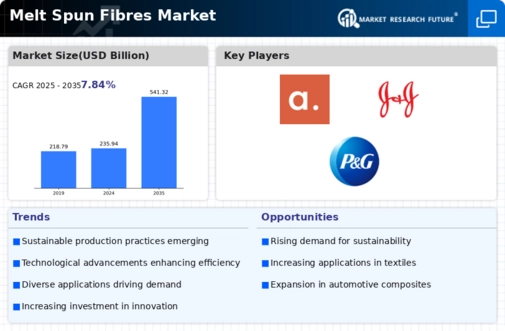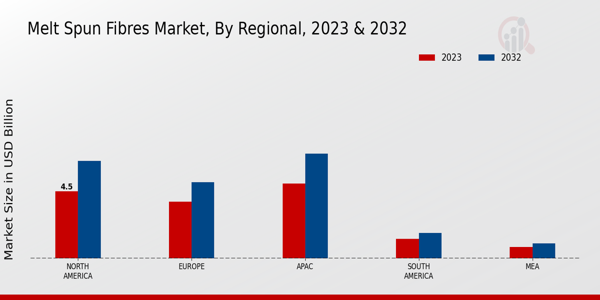Market Growth Projections
The Global Melt Spun Fibres Market Industry is projected to experience substantial growth over the coming years. With a market size expected to reach 541.32 USD Billion by 2035, the industry is poised for a robust expansion trajectory. This growth is underpinned by various factors, including rising demand for sustainable materials, technological advancements, and increased applications across diverse sectors. The anticipated CAGR of 7.84% from 2025 to 2035 indicates a strong upward trend, suggesting that the market is likely to attract significant investments and innovations. As industries continue to evolve, the melt spun fibres market is expected to play a crucial role in meeting the demands of modern consumers and businesses.
Rising Demand for Sustainable Materials
The Global Melt Spun Fibres Market Industry experiences a notable surge in demand for sustainable materials, driven by increasing environmental awareness among consumers and manufacturers. As industries pivot towards eco-friendly practices, melt spun fibres, known for their recyclability and lower environmental impact, gain traction. This shift is evident in the textile sector, where brands are increasingly adopting melt spun fibres to meet sustainability goals. The industry's growth is projected to reach 235.94 USD Billion in 2024, reflecting a growing preference for sustainable solutions. This trend not only enhances brand reputation but also aligns with global initiatives aimed at reducing carbon footprints.
Expanding Applications Across Industries
The versatility of melt spun fibres contributes significantly to the expansion of the Global Melt Spun Fibres Market Industry across various sectors. These fibres find applications in textiles, automotive, and medical industries, among others. For example, in the automotive sector, melt spun fibres are utilized for lightweight and durable components, enhancing fuel efficiency. In the medical field, they are employed in the production of non-woven fabrics for surgical masks and gowns. This broad applicability indicates a robust growth trajectory, as industries increasingly recognize the benefits of melt spun fibres. The market is expected to grow at a CAGR of 7.84% from 2025 to 2035, reflecting the rising demand across diverse applications.
Technological Advancements in Production
Technological advancements play a pivotal role in shaping the Global Melt Spun Fibres Market Industry. Innovations in production processes, such as enhanced spinning techniques and automation, lead to improved efficiency and reduced costs. These advancements enable manufacturers to produce high-quality melt spun fibres at a competitive price, thereby expanding their market reach. For instance, the integration of artificial intelligence in production lines optimizes resource utilization and minimizes waste. As a result, the industry is poised for substantial growth, with projections indicating a market size of 541.32 USD Billion by 2035. This evolution in technology not only boosts productivity but also enhances product quality.
Growing Consumer Awareness and Preferences
Consumer awareness regarding the benefits of melt spun fibres significantly influences the Global Melt Spun Fibres Market Industry. As consumers become more informed about the advantages of these fibres, such as their durability, comfort, and ease of maintenance, demand continues to rise. This trend is particularly evident in the apparel sector, where consumers increasingly seek high-performance fabrics that offer both functionality and style. Brands that incorporate melt spun fibres into their products are likely to attract a larger customer base, thereby driving market growth. The industry's expansion is further supported by the anticipated increase in market size to 235.94 USD Billion in 2024, reflecting changing consumer preferences.
Increased Investment in Research and Development
Investment in research and development is a crucial driver for the Global Melt Spun Fibres Market Industry. Companies are allocating significant resources to innovate and enhance the properties of melt spun fibres, such as improving their strength, durability, and thermal resistance. This focus on R&D not only fosters product differentiation but also addresses specific industry needs, thereby expanding market opportunities. For instance, advancements in fibre technology have led to the development of melt spun fibres with enhanced moisture-wicking properties, appealing to the sportswear segment. As a result, the industry is likely to witness accelerated growth, supported by continuous innovation and the introduction of new products.





